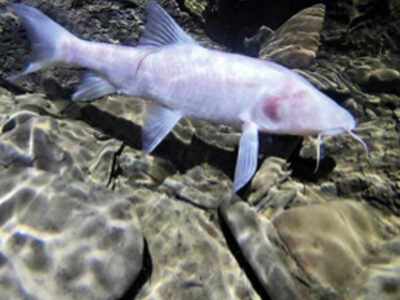
It was white, with translucent fins and tails, and had no eyes. But it caught the attention of Dr DB Harries, a biologist at Heriot-Watt University in Edinburgh, on a caving expedition in Meghalaya's Jaintia Hills. Something about it stood out. So he went back the following day, with biscuits and a net.
"After several failed attempts, I managed to catch one by putting biscuits in a large bag and sinking it in the pool. I was surprised by how large the fish was, over 40 cm. But I didn't realise at the time it was bigger than any known cave fish in the world," he said. The average length of the 250 known subterranean fish species is about 8.5cm.
"It's generally assumed that since food is scarce in caves, animals like fish would be small in size and occur in relatively low numbers. But here, we have one that's over 10 times bulkier than other species of cave fish and in a population of about 100. In one cave," said Harries, a member of the Grampian Speleogical Group, Scotland's largest caving club. Once home, he sent the photos to a cave fish specialist in the UK, who told him it was "something extraordinary" and suggested getting in touch with fish specialists in India. It was then that they realised it was the largest cave fish in the world. But as they studied the fish, they realised there was more.
"The finding is evolutionarily important as this is also the world's first cave-adapted form of the genus Tor (Golden Mahseer, a game fish species found in fast-flowing rivers). This will hold the key to the evolutionary history and biogeography of the fish species and the area," said Rajeev Raghavan from the Kerala University of Fisheries and Ocean Studies, a co-author of the paper.
The caves of Meghalaya have been the site of many discoveries. Since each cave has a unique, insular ecology, most life forms found there may be restricted to just one cave system.
Localised impacts have been many. At one point, entrances to the 24 Kotsati-Umlawan caves in Jaintia Hills were blocked by deposits from limestone quarries. Cement factories operate all around and often very close to the caves. "Where there should be one plant in a 10-km radius, eight have come up," said Agnes Kharshiing, an activist who survived an attack by Meghalaya's mining mafia in 2018. "At Nongtrai (in East Khasi Hills), limestone mining is slowly hollowing out the ground underneath caves, which may subside at any time," she added.
Duwaki Rangad, a zoologist from St Edmund's College in Shillong who co-wrote the paper, agreed. "Effluents from industries have polluted rivers and water bodies - like the Lukha river, which turns an unnatural blue intermittently. That would have an impact on life forms within caves, where the waters flow in," said Rangad.
"After several failed attempts, I managed to catch one by putting biscuits in a large bag and sinking it in the pool. I was surprised by how large the fish was, over 40 cm. But I didn't realise at the time it was bigger than any known cave fish in the world," he said. The average length of the 250 known subterranean fish species is about 8.5cm.
"It's generally assumed that since food is scarce in caves, animals like fish would be small in size and occur in relatively low numbers. But here, we have one that's over 10 times bulkier than other species of cave fish and in a population of about 100. In one cave," said Harries, a member of the Grampian Speleogical Group, Scotland's largest caving club. Once home, he sent the photos to a cave fish specialist in the UK, who told him it was "something extraordinary" and suggested getting in touch with fish specialists in India. It was then that they realised it was the largest cave fish in the world. But as they studied the fish, they realised there was more.
"The finding is evolutionarily important as this is also the world's first cave-adapted form of the genus Tor (Golden Mahseer, a game fish species found in fast-flowing rivers). This will hold the key to the evolutionary history and biogeography of the fish species and the area," said Rajeev Raghavan from the Kerala University of Fisheries and Ocean Studies, a co-author of the paper.
The caves of Meghalaya have been the site of many discoveries. Since each cave has a unique, insular ecology, most life forms found there may be restricted to just one cave system.
Localised impacts have been many. At one point, entrances to the 24 Kotsati-Umlawan caves in Jaintia Hills were blocked by deposits from limestone quarries. Cement factories operate all around and often very close to the caves. "Where there should be one plant in a 10-km radius, eight have come up," said Agnes Kharshiing, an activist who survived an attack by Meghalaya's mining mafia in 2018. "At Nongtrai (in East Khasi Hills), limestone mining is slowly hollowing out the ground underneath caves, which may subside at any time," she added.
Duwaki Rangad, a zoologist from St Edmund's College in Shillong who co-wrote the paper, agreed. "Effluents from industries have polluted rivers and water bodies - like the Lukha river, which turns an unnatural blue intermittently. That would have an impact on life forms within caves, where the waters flow in," said Rangad.
Trending Topics
LATEST VIDEOS
City
 Bhuj sect's Swami stirs controversy, says 'If menstruating women cook food, they will be born as bitch in next life'
Bhuj sect's Swami stirs controversy, says 'If menstruating women cook food, they will be born as bitch in next life'  30 kg gold looted in Ludhiana, robbers caught on camera
30 kg gold looted in Ludhiana, robbers caught on camera  Jamia student files case against Delhi police, seek Rs 1 crore as compensation
Jamia student files case against Delhi police, seek Rs 1 crore as compensation  Mangaluru restaurant offers complementary biryani to blood donors
Mangaluru restaurant offers complementary biryani to blood donors
More from TOI
Navbharat Times
Featured Today in Travel
Get the app



